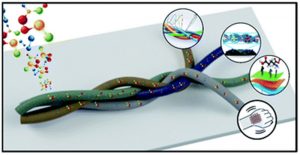
By Dr. Radhakrishnaiah Parachuru
Textiles are rapidly emerging as the cheapest and most versatile components of microfluidic devices. Microfluidics is the branch of science which deals with the behavior of fluids through micro channels. It also deals with the technology of manufacturing miniaturized devices containing chambers and tunnels through which fluids can flow or remain confined. These devices work with very small volumes of fluids, down to 1 cc or so. Fluids behave very differently on the micrometric scale than they do in bulk quantities. The unique features and behaviors of tiny volumes of fluids absorbed into micro channels play unique detection and diagnostic roles in new scientific experiments and a plethora of emerging new devices.
Polymers are widely used to fabricate microfluidic devices. Both thermoplastics and thermosets have found extensive use. Their preference is due to the fact that they are robust, inexpensive and remain stable under strong bio-chemical environments. The availability of a wide range of polymeric materials and the possibility of modifying their properties through chemical and thermal means are other factors that govern their popularity. In recent years, low-cost microfluidic devices based on mono and multifilament threads and fabricated textiles have found important applications in disease detection, diagnosis and environmental mitigation. Hydrophilic multifilament threads are capable of transporting aqueous and non-aqueous fluids via capillary action and they possess desirable properties for building fluid transport pathways in microfluidic devices. Figure 1 illustrates a thread-based system.
These devices are usually integrated with one or more analysis techniques such as electrochemical, colorimetric, electrophoretic, chromatographic and fluorescence techniques. The combination allowed the construction of fully portable devices suitable for point-of-care and wearable applications.
Threads can also be used to manufacture fabrics which can be patterned to achieve suitable hydrophilic-hydrophobic control. A combination of hydrophilic and hydrophobic threads can be used to fabricate precisely controlled low-cost fabric patterns which will serve as inexpensive microfluidic devices. Recent research on textile microfluidic devices focused on modelling of the fluid flow in microfluidic thread and textile-based systems. The work also focused on thread surface treatments and the potential of combining multifilament threads with other materials to construct devices with expanded functionality.
Fabric-based 2D and 3D microfluidic devices fabricated using organic cotton and wax have demonstrated how instant absorption of tiny volumes of colored fluids in preferred locations can be accomplished. These devices are suitable for colorimetric protocols whose sensing principle is based on color change. Anhydrous sodium bicarbonate (NaHCO3) was used to remove the natural wax from preferred locations of the fabric to make these locations hydrophilic in nature. It was shown that by removing natural wax and applying wax to cotton in preferred patterns, side-by-side hydrophilic-hydrophobic zones down to 1 millimeter size can be created in an ordinary cotton fabric. The fabric containing tiny zones that can either attract or repel fluids can be used to detect the presence or absence of fluids, including contaminated and differently colored fluids.
Water pollution is a major problem today causing shortage of fresh water around the globe. Heavy metals, pharmaceutical waste materials, organic and inorganic contaminants present in water bodies are posing significant threats to the environment and public health. Currently available monitoring techniques involve complex equipment, longer processing time, and highly skilled professionals, making these techniques expensive and inaccessible. Towards achieving a portable, highly sensitive, and selective water quality control system, microfluidic devices have emerged as the preferred choice. Several researchers have turned their attention to the microfluidic devices and are focusing on the development of appropriate devices for the detection of contaminants in water. Polymer and textile-based microfluidic devices are expected to play a big role in detecting and removing the pollutants present in global water bodies.
Editor’s Note: Dr. Radhakrishnaiah Parachuru is a professor in the School of Materials Science & Engineering at the Georgia Institute of Technology in Atlanta.
February 9, 2023




